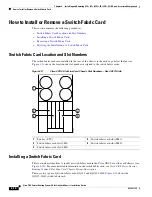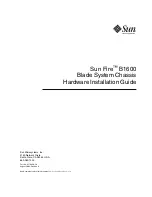
4-4
Cisco CRS Carrier Routing System 4-Slot Line Card Chassis Installation Guide
OL-10971-10
Chapter 4 Installing and Removing SFCs, RPs, MSCs, FPs, LSPs, PLIMs, and Associated Components
About Installing and Removing Cards and Associated Components
Note
See the instructions in this chapter for details on how to install the individual cards.
Guidelines
When you install or remove cards on the Cisco CRS 4-slot line card chassis, follow these guidelines:
•
Do not operate the Cisco CRS 4-slot line card chassis with any slots completely empty; doing so can
lead to an airflow bypass condition that diverts airflow from slots containing heat-generating
electronics. This situation can cause thermal alarms to occur at lower-than-expected ambient
temperatures. To avoid airflow bypass, make sure that all slots are filled with their appropriate cards
or impedance carriers. If you have to replace a card, we recommend leaving the card in place in the
chassis until you are ready to install the new one.
•
When you remove a card, always use the ejector levers to ensure that the connector pins disconnect
from the midplane in the sequence expected by the router.
•
To lessen the possibility of damaging the connectors on the chassis midplane, you should visually
inspect the connector pins on the cards before you insert them into the chassis.
PCMCIA Cards
Optional and replaceable PCMCIA cards are available for the RP cards. The RP cards provide two
PCMCIA flash slots, each card providing up to 1 GB of flash storage. One of the PCMCIA flash
subsystems is accessible externally, is removable, and allows you to transfer system images and
configurations by plugging in a PCMCIA flash card. The other subsystem is fixed to the RP, is not
removable, and is used for permanent storage of configurations and system images.
Note
Only the original route processor (RP) card uses a PCMCIA card. The performance route processor
(PRP) card has a USB connector for using a flash drive.
Small Form-Factor Pluggable (SFP) Modules
The SFP module for the Cisco CRS 4-slot line card chassis uses the bale-clasp latch type.
Caution
Protect the SFP modules by inserting clean dust covers into them after the cables are removed from them.
Be sure to clean the optic surfaces of the fiber cables before you plug them back into the optical ports
of another SFP module. Avoid getting dust and other contaminants into the optical ports of the SFP
modules: The optics do not work correctly when obstructed with dust.
Note
Shared port adapters (SPAs) and the 16-port OC-48c/STM-16c PLIM use SFP modules.








































